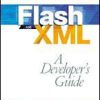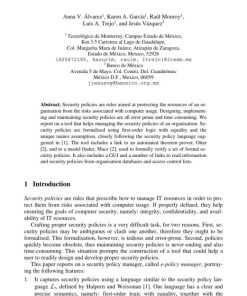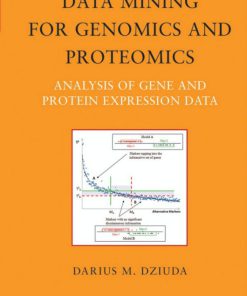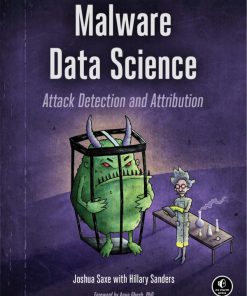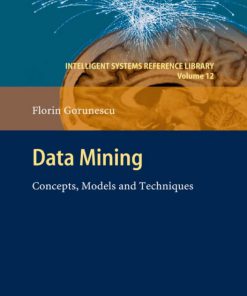Investigative Data Mining for Security and Criminal Detection 1st Edition by Jesus Mena ISBN 0750676132 9780750676137
$50.00 Original price was: $50.00.$25.00Current price is: $25.00.
Authors:by Jesus Mena , Author sort:Mena, by Jesus , Ids:ISBN:0750676132 , Languages:Languages:eng , Publisher:Butterworth Heinemann , Comments:Comments:Published 2003, 452 pages.
Investigative Data Mining for Security and Criminal Detection 1st Edition by Jesus Mena – Ebook PDF Instant Download/Delivery. 0750676132, 9780750676137
Full download Investigative Data Mining for Security and Criminal Detection 1st Edition after payment
Product details:
ISBN 10: 0750676132
ISBN 13: 9780750676137
Author: Jesus Mena
Investigative Data Mining for Security and Criminal Detection is the first book to outline how data mining technologies can be used to combat crime in the 21st century. It introduces security managers, law enforcement investigators, counter-intelligence agents, fraud specialists, and information security analysts to the latest data mining techniques and shows how they can be used as investigative tools. Readers will learn how to search public and private databases and networks to flag potential security threats and root out criminal activities even before they occur.
The groundbreaking book reviews the latest data mining technologies including intelligent agents, link analysis, text mining, decision trees, self-organizing maps, machine learning, and neural networks. Using clear, understandable language, it explains the application of these technologies in such areas as computer and network security, fraud prevention, law enforcement, and national defense. International case studies throughout the book further illustrate how these technologies can be used to aid in crime prevention.
Investigative Data Mining for Security and Criminal Detection 1st Table of contents:
Chapter 1. Precrime Data Mining
1.1 Behavioral Profiling
1.2 Rivers of Scraps
1.3 Data Mining
1.4 Investigative Data Warehousing
1.5 Link Analysis
1.6 Software Agents
1.7 Text Mining
1.8 Neural Networks
1.9 Machine Learning
1.10 Precrime
1.11 September 11, 2001
1.12 Criminal Analysis and Data Mining
1.13 Profiling via Pattern Recognition
1.14 Calibrating Crime
1.15 Clustering Burglars: A Case Study
1.16 The Future
1.17 Bibliography
Chapter 2. Investigative Data Warehousing
2.1 Relevant Data
2.2 Data Testing
2.3 The Data Warehouse
2.4 Demographic Data
2.5 Real Estate and Auto Data
2.6 Credit Data
2.7 Criminal Data
2.8 Government Data
2.9 Internet Data
2.10 XML
2.11 Data Preparation
2.12 Interrogating the Data
2.13 Data Integration
2.14 Security and Privacy
2.15 ChoicePoint: A Case Study
2.16 Tools for Data Preparation
2.17 Standardizing Criminal Data
2.18 Bibliography
Chapter 3. Link Analysis: Visualizing Associations
3.1 How Link Analysis Works
3.2 What Can Link Analysis Do?
3.3 What Is Link Analysis?
3.4 Using Link Analysis Networks
3.5 Fighting Wireless Fraud with Link Analysis: A Case Study
3.6 Types of Link Analysis
3.7 Combating Drug Trafficking in Florida with Link Analysis: A Case Study
3.8 Link Analysis Applications
3.9 Focusing on Money Laundering via Link Analysis: A Case Study
3.10 Link Analysis Limitations
3.11 Link Analysis Tools
3.12 Bibliography
Chapter 4. Intelligent Agents: Software Detectives
4.1 What Can Agents Do?
4.2 What Is an Agent?
4.3 Agent Features
4.4 Why Are Agents Important?
4.5 Open Sources Agents
4.6 Secured Sources Agents
4.7 How Agents Work
4.8 How Agents Reason
4.9 Intelligent Agents
4.10 A Bio-Surveillance Agent: A Case Study
4.11 Data Mining Agents
4.12 Agents Tools
4.13 Bibliography
Chapter 5. Text Mining: Clustering Concepts
5.1 What Is Text Mining?
5.2 How Does Text Mining Work?
5.3 Text Mining Applications
5.4 Searching for Clues in Aviation Crashes: A Case Study
5.5 Clustering News Stories: A Case Study
5.6 Text Mining for Deception
5.7 Text Mining Threats
5.8 Text Mining Tools
5.9 Bibliography
Chapter 6. Neural Networks: Classifying Patterns
6.1 What Do Neural Networks Do?
6.2 What Is a Neural Network?
6.3 How Do Neural Networks Work?
6.4 Types of Network Architectures
6.5 Using Neural Networks
6.6 Why Use Neural Networks?
6.7 Attrasoft Facial Recognition Classifications System: A Demonstration
6.8 Chicago Internal Affairs Uses Neural Network: A Case Study
6.9 Clustering Border Smugglers with a SOM: A Demonstration
6.10 Neural Network Chromatogram Retrieval System: A Case Study
6.11 Neural Network Investigative Applications
6.12 Modus Operandi Modeling of Group Offending: A Case Study
6.13 False Positives
6.14 Neural Network Tools
6.15 Bibliography
Chapter 7. Machine Learning: Developing Profiles
7.1 What Is Machine Learning?
7.2 How Machine Learning Works
7.3 Decision Trees
7.4 Rules Predicting Crime
7.5 Machine Learning at the Border: A Case Study
7.6 Extrapolating Military Data: A Case Study
7.7 Detecting Suspicious Government Financial Transactions: A Case Study
7.8 Machine-Learning Criminal Patterns
7.9 The Decision Tree Tools
7.10 The Rule-Extracting Tools
7.11 Machine-Learning Software Suites
7.12 Bibliography
Chapter 8. NetFraud: A Case Study
8.1 Fraud Detection in Real Time
8.2 Fraud Migrates On-line
8.3 Credit-Card Fraud
8.4 The Fraud Profile
8.5 The Risk Scores
8.6 Transactional Data
8.7 Common-Sense Rules
8.8 Auction Fraud
8.9 NetFraud
8.10 Fraud-Detection Services
8.11 Building a Fraud-Detection System
8.12 Extracting Data Samples
8.13 Enhancing the Data
8.14 Assembling the Mining Tools
8.15 A View of Fraud
8.16 Clustering Fraud
8.17 Detecting Fraud
8.18 NetFraud in the United Kingdom: A Statistical Study
8.19 Machine-Learning and Fraud
8.20 The Fraud Ensemble
8.21 The Outsourcing Option
8.22 The Hybrid Solution
8.23 Bibliography
Chapter 9. Criminal Patterns: Detection Techniques
9.1 Patterns and Outliers
9.2 Money As Data
9.3 Financial Crime MOs
9.4 Money Laundering
9.5 Insurance Crimes
9.6 Death Claims That Did Not Add Up: A Case Study
9.7 Telecommunications Crime MOs
9.8 Identity Crimes
9.9 A Data Mining Methodology for Detecting Crimes
9.10 Ensemble Mechanisms for Crime Detection
9.11 Bibliography
Chapter 10. Intrusion Detection: Techniques and Systems
10.1 Cybercrimes
10.2 Intrusion MOs
10.3 Intrusion Patterns
10.4 Anomaly Detection
10.5 Misuse Detection
10.6 Intrusion Detection Systems
10.7 Data Mining for Intrusion Detection: A Case Study from the Mitre Corporation
10.8 Types of IDSs
10.9 Misuse IDSs
10.10 Anomaly IDSs
10.11 Multiple-Based IDSs
10.12 Data Mining IDSs
10.13 Advanced IDSs
10.14 Forensic Considerations
10.15 Early Warning Systems
10.16 Internet Resources
10.17 Bibliography
Chapter 11. The Entity Validation System (EVS): A Conceptual Architecture
11.1 The Grid
11.2 GRASP
11.3 Access Versus Storage
11.4 The Virtual Federation
11.5 Web Services
11.6 The Software Glue
11.7 The Envisioned EVS
11.8 Needles in Moving Haystacks
11.9 Tracking Identities
11.10 The AI Apprentice
11.11 Incremental Composites
11.12 Machine Man
11.13 Bibliography
Chapter 12. Mapping Crime: Clustering Case Work
12.1 Crime Maps
12.2 Interactive Crime GIS
12.3 Crime Clusters
12.4 Modeling the Behavior of Offenders Who Commit Serious Sexual Assaults: A Case Study
12.5 Decomposing Signatures Software
12.6 Computer Aided Tracking and Characterization of Homicides and Sexual Assaults (CATCH)
12.7 Forensic Data Mining
12.8 Alien Intelligence
12.9 Bibliography
A: 1,000 Online Sources for the Investigative Data Miner
B: Intrusion Detection Systems (IDS) Products, Services, Freeware, and Projects
C: Intrusion Detection Glossary
D: Investigative Data Mining Products and Services
People also search for Investigative Data Mining for Security and Criminal Detection 1st:
investigative data mining for security criminal detection
investigative data mining for security and criminal detection
types of security investigations
what is crime detection and investigation
investigative data


